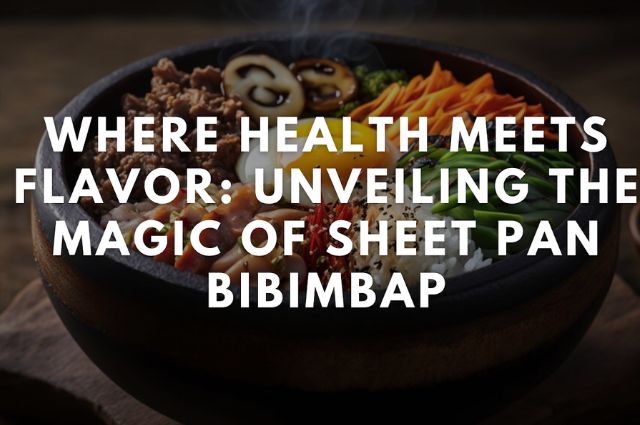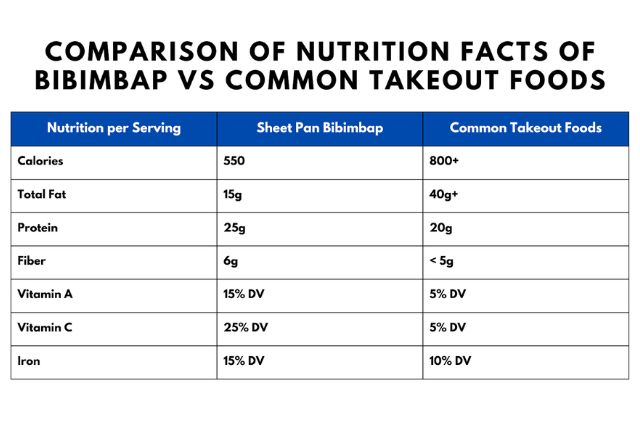
Sheet pan meals have been gaining popularity over the last few years, providing a convenient and healthy one-pan cooking method for busy home cooks. These hands-off dinners make efficient use of the oven to roast vegetables and proteins to perfection all on one sheet pan.
Now, this technique is breathing new life into a classic Korean favorite – Bibimbap.” Grammar and punctuation: The infusion of traditional Bibimbap flavors into a simplified preparation elevates weeknight dinners to new heights of taste and nutrition.
Origins and Evolution of Bibimbap
Bibimbap traces its roots to the Koryo dynasty era in Korea, first mentioned in texts from the late 19th century. The name itself translates to “mixed rice” – an apt description of the signature medley of ingredients that characterize the dish. Originally, Bibimbap was considered a specialty of the city of Jeonju, using the abundant local produce of the region.
Over time, the dish evolved across Korea with variations in ingredients and preparation methods emerging. The common thread remained the same – a bowl of warm white rice topped artfully with namul (sautéed and seasoned vegetables), gochujang-based sauce, meat or eggs, and garnish.
From this classic template, modern interpretations have expanded Bibimbap’s versatility, making it suitable for both everyday meals and celebratory occasions.
As Korea modernized during the 20th century, bibimbap proliferated in cookbooks and restaurants. Its reputation grew as a healthy, balanced dish combining rice, protein, spices, and an array of vegetables. Traditional Bibimbap is served in a searing-hot dolsot (stone bowl), allowing crispy rice crust (nurungji) to form at the bottom. The signature Korean chili paste sauce, gochujang, adds sweet yet spicy contrast.
While traditional stone pot methods remain popular, various contemporary interpretations have emerged. Some restaurants serve sheet pan bibimbap in personal sized sheet pans for tableside mixing and crisp edges reminiscent of the stone pot crunchy rice texture. The sheet pan preparation method streamlines cooking by roasting ingredients together with cohesive results.
As bibimbap gains popularity globally, creative innovations allow it to transform into an emblem of Korean cuisine itself – both traditional and modern interpretations alike.
Deconstructing Bibimbap
At first glance, Bibimbap is a simple rice bowl – but the nuances of texture and flavor transform it into a complex culinary jewel. The foundation of the dish begins with a base of fluffy steamed rice, providing carbohydrate fuel. Toppings offer a rainbow of tastes and health benefits through vegetables like spinach, carrot, bean sprouts and shiitake mushrooms.
For protein power, beef, chicken, or fried egg are popular choices. The crowning glory is the spicy-sweet gochujang sauce, bringing everything together with its slight fermented kick paired with honey or rice syrup. Roasted sesame oil and toasted sesame seeds add nuttiness and textural contrast.
When combined in one bowl and mixed together just before eating, temperatures, flavors and ingredients coalesce into perfect harmony. The adaptability of Bibimbap lends itself well to customization too – swap in seasonal vegetables, different proteins, grains like quinoa, and garnishes to match one’s taste.
The Sheet Pan Revolution
In recent years, sheet pan dinners have emerged as a prime solution for quick and easy dinner recipes. Requiring only 5 ingredients or less, everything cooks on a single sheet pan in the oven.
Sheet pan meals have surged in popularity, with searches for “sheet pan dinners” increasing by over 600% in the past five years, indicating a growing interest in convenient and efficient cooking methods.
Hands-off roasting allows the natural flavors of ingredients to intensify without needing excessive seasoning or complicated techniques. Preparation is streamlined by simply chopping vegetables and proteins, tossing them with oil and spices, and roasting until perfectly caramelized.
Sheet pan meals also tend to be well-balanced nutritionally since all components – grain, protein, and ample vegetables – cook together. These simplified sheet pan meals also tend to be well-balanced nutritionally since all components – grain, protein, and ample vegetables – cook together. Cleanup involves just one pan rather than multiple pots and dishes. For those seeking effortless, satisfying meals, sheet pan dinners check all the boxes.
The Marriage of Bibimbap and Sheet Pan Cooking
While traditional stone-pot Bibimbap holds an irreplaceable nostalgic charm, everyday cooking habits have evolved in modern households. This is where sheet pan Bibimbap offers the best of both worlds – retaining the classic tastes of Korea in a streamlined format.
Cooking the components together on one sheet pan mimics the signature mixing process where rice absorbs the juices and flavors of the toppings as they are stirred together. The seamless infusion happens in the oven instead of the bowl. Sheet pan Bibimbap also eliminates the need for multiple side dishes – built right in are protein, grains, and a medley of vegetables for a balanced one-plate meal.
Cook once, enjoy twice by repurposing leftovers into lunch bowls, fried rice, or lettuce wraps. Embrace this innovative yet authentic union perfect for everything from casual family dinners to special occasions.
Health Benefits of Sheet Pan Bibimbap
Beyond tempting the taste buds, sheet pan Bibimbap delivers a powerhouse of nutritional benefits tailored for a healthy lifestyle. Rice supplies balanced complex carbohydrates while an abundance of vegetables like spinach, carrots, zucchini and mushrooms packs vitamins, minerals and fiber.
The array of colorful produce boosts antioxidants to combat inflammation and cell damage associated with chronic diseases.
Lean beef or chicken provides protein for staying power and egg yolks contain choline for brain and nerve health. Spicy gochujang paste adds vitamin C and capsaicin for metabolism and immunity. Roasted sesame oil and seeds supply vitamin E, magnesium, zinc, iron and plant-based fats for glowing skin and heart health.

This wholesome balance supports weight management, energy levels, gut health, and overall wellness goals.
Flavor Explosion: Key Ingredients and Seasonings
A few specialty ingredients take sheet pan Bibimbap to new dimensions of flavor while retaining an authentic taste.
The complex sweet-spicy-earthy tang comes from gochujang, a fermented red chili paste brewed from sticky rice, chili powder and soybeans. Its slight funk pairs perfectly with the natural sugars of carrot and honey or rice syrup added to the sauce. Toasted sesame oil provides a rich, nutty aroma that is impossible to replicate.
Roughly chopped kimchi offers a tangy counterpoint while boosting the probiotic properties. Splashes of rice vinegar and soy sauce enhance umami notes. Crispness comes from short-grain white rice contrasting the softer sautéed vegetables – uniform grains allow for even coating and absorption of juices. A crowning shower of toasted sesame seeds gives the satisfying crunch factor reminiscent of traditional stone pot fare.
Cooking Process and Tips
One of the beauties of sheet pan Bibimbap lies in its flexibility – use whatever proteins, vegetables and grains you prefer. Customize to dietary needs by swapping ingredients. The preparation requires some initial chopping then everything cooks low and slow while flavors meld together. Follow this basic bibimbap recipe then tweak components to your taste:
Prep ingredients:
- 3 cups pre-cooked short grain rice
- 1 pound protein (beef, chicken, or tofu) chopped
- Assorted vegetables, roughly chopped (carrots, spinach, broccoli, mushrooms etc.)
- 2 eggs
- Kimchi, chopped (optional)
- Toasted sesame seeds, for garnish
Vegetarian/Vegan: Substitute tofu, tempeh or eggs for meat. Use mushroom or miso broth instead of soy sauce for a vegetarian bibimbap.
Make sauce:
- 3 Tbsp gochujang paste
- 1 Tbsp honey or rice syrup
- 1 Tbsp soy sauce
- 1 Tbsp rice vinegar
- 1 Tbsp toasted sesame oil
- 1 tsp garlic, minced
- 1 tsp ginger, minced
Cook:
- Toss protein and vegetables with 1 Tbsp olive oil, salt and pepper.
- Arrange on a sheet pan non-stick or lined with parchment paper.
- Roast 25 minutes at 400°F, tossing halfway through.
- Push ingredients to the edges of pan. Add eggs to center and pierce yolks.
- Roast 5 more minutes until eggs reach desired doneness.
- Mix sauce ingredients.
- Add roasted ingredients back into pan, drizzle sauce evenly. Toss gently to coat.
- Portion rice into bowls. Top with sheet pan mixture.
- Garnish with kimchi, sesame seeds to taste.
Tips:
- For perfect rice texture, use day old or par-cooked rice.
- Substitute quinoa or barley for rice alternative.
- Tailor vegetables to seasonal variety.
- Make extra sauce to serve on the side.
Frequently Asked Questions
- Can I customize Sheet Pan Bibimbap to accommodate dietary restrictions?
Absolutely! The beauty of sheet pan Bibimbap lies in its flexibility to adapt based on individual needs:
- Vegetarian/Vegan: Substitute tofu, tempeh or eggs for meat. Use mushroom or miso broth instead of soy sauce.
- Gluten-Free: Swap rice for quinoa or rice noodles. Use tamari instead of soy sauce.
- Dairy-Free: Omit cheese if added. Substitute coconut aminos for soy.
- Low-Carb: Serve smaller portions of rice, bulk up on extra vegetables.
- Food Allergies: Omit problematic ingredients and find safe swaps like chickpeas for eggs.
- How do I prevent the rice from becoming soggy during sheet pan cooking?
Using day-old or pre-cooked rice is the best technique. The grains have already absorbed moisture and retain the perfect tender yet toothsome texture once roasted with juices. Alternatively, par-cook fresh rice by boiling for a few minutes then drying out excess water before sheet pan cooking.
- Can Sheet Pan Bibimbap be made ahead of time for meal prep purposes?
The components store excellently for easy reheating throughout the week. Cook rice and roast sheet pan mixture a day or two ahead. Store rice separately from protein and veggies to prevent sogginess. Sauce can be made fresh or kept for one week refrigerated. Reheat rice with a splash of water to revive texture. Quickly stir fry sheet pan mixture or serve chilled or room temp rice as a no-cook option.
Conclusion
Sheet pan Bibimbap brings together the soul-satisfying ingredients of a classic Korean favorite into a streamlined, stress-free cooking method perfect for hectic modern lifestyles. Using the oven to allow signature flavors to mingle and textures to harmonize eliminates the need for complex techniques.
Rethink the rice bowl with this innovative yet comforting dish, equally enjoyable for casual family dinners, easy meal prep and even special occasions with an elegant touch. Health meets flavor when Bibimbap meets sheet pan with delicious results guaranteed to become a staple recipe for every routine.






